Liriope muscari ‘Variegata’, also known as Variegated Lilly Turf.
Variegated Liriope is an awesome landscape and I tell you why. It’s colorful, it flowers, it’s attractive and it’s super easy to care. I’ve used this plant in landscape plants for years and 20 years later it still looks good. It never gets too big, it never gets too scraggly, it just looks good.
The only maintenance it needs is to have the top clipped off at the end of the growing season, or really early in the next growing season. That’s it. New shoots come from the ground each spring and it looks amazing all summer long.
Sometimes I use Variegated Liriope in mass plantings, planted as close together as 12 to 18 inches, other times, often times really, I use it to border a long curved walk. Or to border the outside of a large planting bed.
This is an awesome plant to grow and sell for a lot of reasons but it has great sales appeal because it makes an excellent border plant or can be used in a mass planting, but more important than that it’s a plant that you’ll ever regret using in a landscape.
When I was doing a lot of landscaping there were plants that I used in many, if not most of my plantings and there were plants that I would almost never use in a landscape planting because they grew too fast, were to difficult to care for or just because scraggly over time. Variegated Liriope was a plant that I was proud to put in my landscapes because I knew it would look good for 20 years or more.
Caring for Variegated Liriope.
This plant is super easy to care for. I touch mine once a year in my landscape. At the very end of the growing season, usually mid November here in northern Ohio we simply pull the top of the plant up into a “ponytail” with one hand and clip off that pony tail below the hand being used to hold it up. That leaves just an inch or two of leaf stubs sticking up.
Come spring the new leaves will emerge and completely engulf what’s left of the old leaves. That’s it! No other trimming required, I never fertilize any of the plants in my landscape, I don’t spray them, I just enjoy them.
Propagating Variegated Liriope.
The best and easiest way to propagate this plant is through simple division. It is the nature of the plant to keep producing more and more new crowns and those crowns can easily be split off and used to start new plants.
The ideal time to propagate this plant is in the very late fall, or early spring. The top of Variegated Liriope does not die back quickly and obviously during the winter months. It droops down but doesn’t really lose it color. And unlike something like Hosta, the leaves remain firmly attached to the plant.
That actually makes dividing it a bit easier. Gives you a handle to hold on to.
Step one. Dig out a plant and put it on your work table or potting bench.
This is a complete plant that I simply “popped” out of the ground with a spade. The first thing I’m going to do is rough this plant up a bit by banging it on the potting bench the knock away any excess soil that I can. The goal is to expose and loosen the roots as much as possible.
Mission accomplished. After rough up the plant a bit I’ve managed to knock loose much of the soil surrounding the roots.
Step Two. Begin the process of Dividing the crowns.
You can pull the crowns apart any way you can by using your fingers to pry the roots apart and break off pieces of the plant. This plant was in my landscape for a number of years so the root mass is really tight so I used a soil knife to cut through the middle of the root ball. After that I was able to tear the plant into pieces with my hands.
Each piece is made up of a single crown.
Step three. Trim the tops of the divisions.
What I do is gather three, four or five divisions in my hand, lining up the crowns at the soil line, then I snip off the tops leaving about an inch or so that will be above the soil line in the pot.
Actually this is a liner, but not a plug. A plug is a plant that is grown in a plug tray and can easily be slipped out of the plug tray roots and soil intact. This is a bare root liner. And a liner like this is sale-able as is.
Right now In Our Members Area I’m sure there a people that would jump at the chance to buy some Variegated Lirope liners as shown above. That’s how this business works. You can’t grow and sell a plant unless you have a parent plant, or a number of parent plants that you can use to start building your inventory from. Our members are always on the look out for plants like this that they can buy and when they are offered they scoop them up quickly.
People are always asking me; “Mike, what do you mean when you say heel in.” Basically that means that I’ve simply placed the plants, usually bare root plants, into a pile of potting soil, or sometimes into the ground temporarily. Usually clumped together like I’ve done here, small bundles then stuck in a hole and backed fill around with soil.
In this case I simply heeled them into potting soil that was already on the potting bench. Once heeled in I wet them down really well to make sure the roots are nice and wet and to wash the soil down around the roots eliminating any air pockets that could dry out the roots.
Plants are heeled in the ground can stay that way for weeks in mild, not hot weather. In this case, heeling them in the soil on the potting bench we will get them potted up within the next 24 hours.
As a grower at home you could plant out a bed of Variegated Liriope in your backyard then once a year dig it up and divide it, keep just enough to replant the bed nice and full and sell of all of the extras that you have. In a situation like that I would plant them 6″ on center and dig them every year and divide them.
Dividing them more often is much easier than what I did here because my plants were older, more established, and pretty well root bound. Not ideal when growing to divide and sell. It will work just fine, but if I had a bed to divide often they would come apart nice and easy and I probably wouldn’t have to use the soil knife at all.
There you have it! Growing, selling and propagating Variegated Liriope.
Questions or comments post them below.

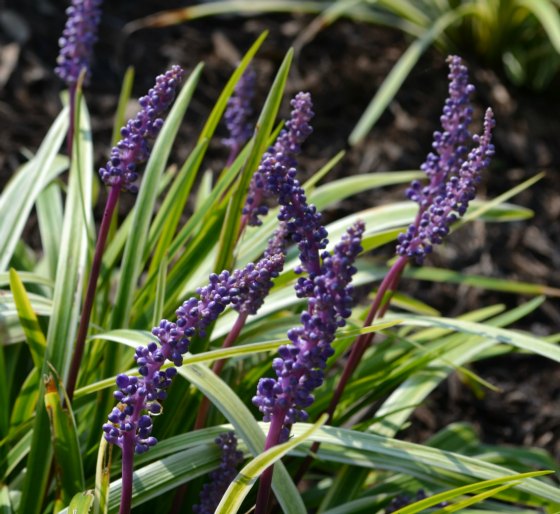
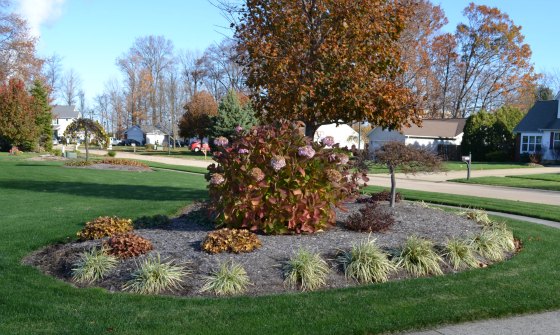
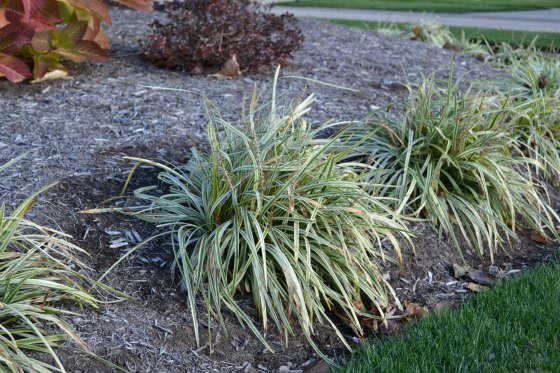
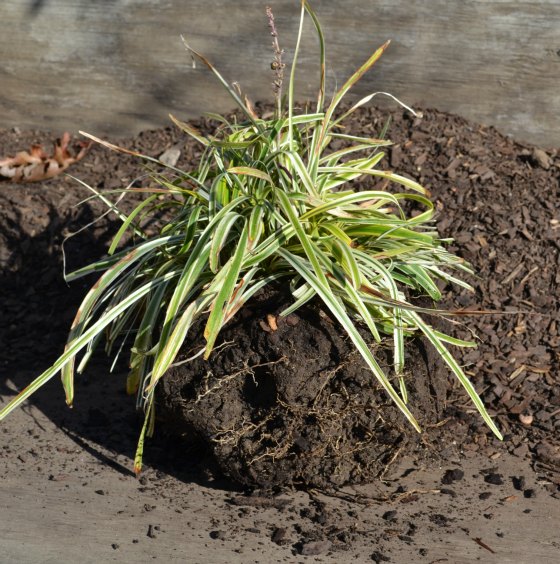
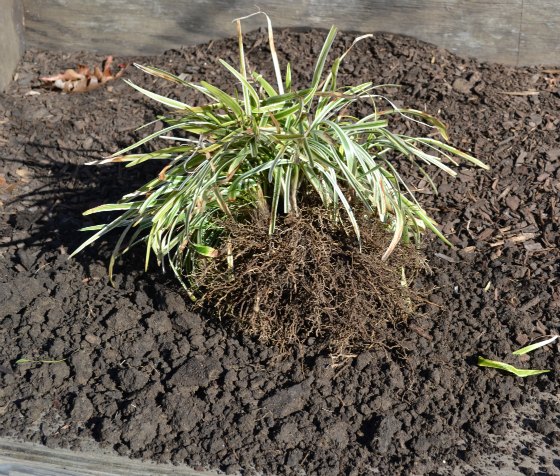
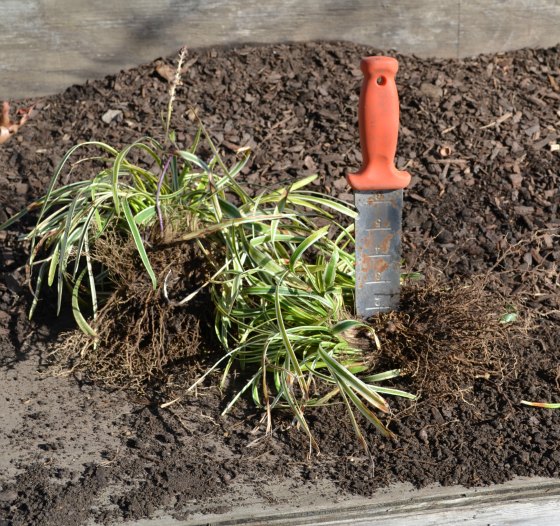
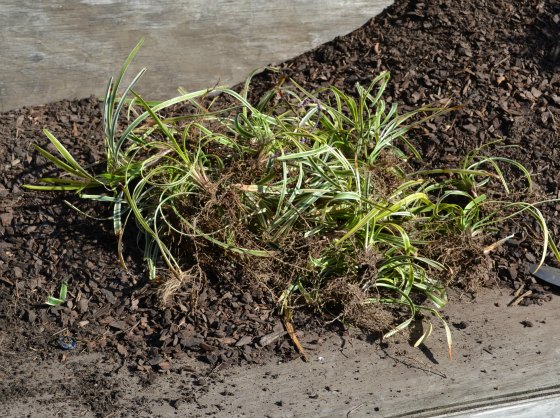
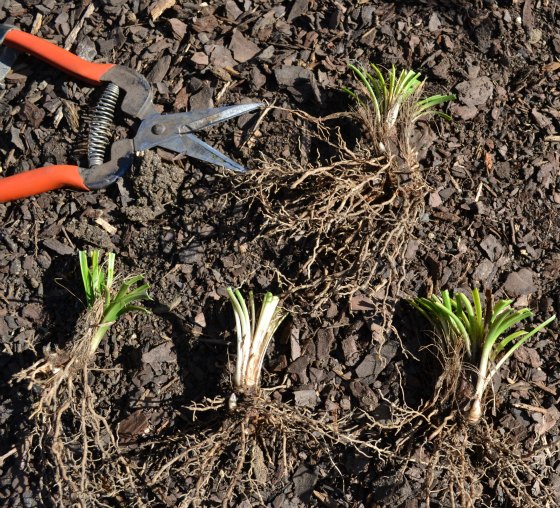
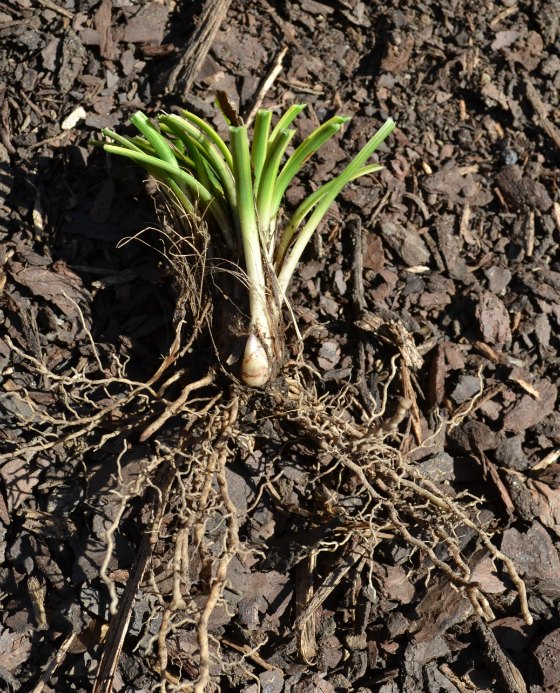
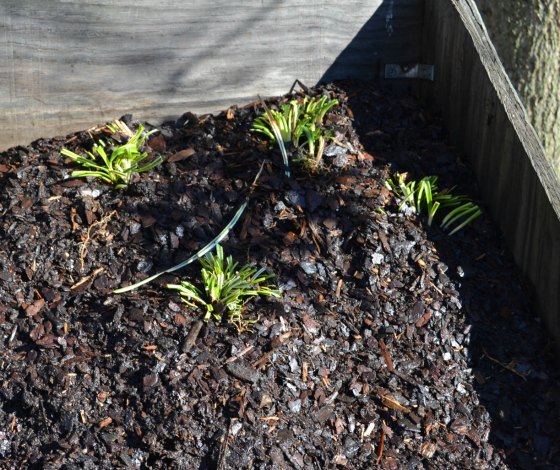
Hello Mike
How can I get a partner in USA; I am producing Aztec Grass and Liriope muscari. here in Honduras Central American
Jose,
I would expect that to be difficult. It’s not impossible to ship across international borders but it’s expensive and challenging. Those two items are far too easy to produce here for anybody to want to import them. At least I think that’s the case.
Its May 12 and the liriope I have arent popping up yet. Do they normally take this long to do this?
Hunter, they can be slow in the spring, I’d give them more time. They don’t over winter well in pots.
It is may 12 and my big blue and variegated liripoe are not popping out of the ground and are looking like they died.Do they normally take this long to come up
Hi Mike,
If you are selling a bare root liner, how do you prepare and keep the liner during the shipping process. I am concerned about how to do this when I start selling.
Also, regarding the liriope, if I separate mine in the fall, will there be a market for the liners at that time?
Nancy
Nancy,
The members areas, http://backyardgrowers.com/join is open right now, you really should take the test drive. I always tell people, if you have not purchased plants from several vendors that ship, you really shouldn’t be shipping plants until you’ve received plants. See this https://mikesbackyardnursery.com/2013/08/how-to-ship-plants-by-mail-ups-or-fed-ex/. After dividing the lirope you should let them develop roots before selling them. I had really poor luck dividing them in the fall, great success in the spring.
Thanks Mike,
I am currently a member. I have not yet made a purchase. I have sent a few questions in by email that Duston has been great to help answer or refer me to links that do. I love the accessibility you offer to people truly passionate about learning about and growing, rooting, and selling plants. Thanks for all you do and offer.
I will wait until the Spring to divide the liriope I have. I also have three 4′-5′ Emerald Green Arborvitaes I purchased for $11 each on clearance – upon your recommendation. They are beautiful – as well as the other stock plants with which I am building my inventory to take cuttings. My next step is to get my license and learn the ropes for packaging and shipping. I expect to be ready by 2018 and looking forward to giving this a real go!
Thanks again!
Nancy
Nancy,
If you have my, https://mikesbackyardnursery.com/mikes-plant-propagation-kit/, you can do those arborvitae in August and they should root easily. See this; https://mikesbackyardnursery.com/2012/07/emerald-green-arborvitae/
Hi Mike,
I am a new member and a couple of times you have mentioned being “a licensed grower”. I understand the need but can u give more information on how to become licensed.
Thanks
Kathy
Kathy,
The process is very simple, just contact the dept of agriculture in your state, find an application online for a growers or producers license and send it in.
When can a Juniper be rooted? In the fall as a hardwood cutting.
Bernice,
If you are using this, https://mikesbackyardnursery.com/mikes-plant-propagation-kit/, then you can do them in July. If not, do them in the fall and keep them watered until it freezes. They will be very slow to root, but they will root.
Mike, I am not a member but I do have lots of the Lipriope grass. I have the kind that grows in clumps & is tall & slender. Do you have any buyers for this grass? I have about 50 to l00 bare roots.
Bernice,
The only way to sell this would be through the members area if you are a licensed grower.
Love your site and learning’s. God gave us all a lot to work with and for.
I too would like ti win a membership.
Thank you for your site to us all.
Hello to you and your lovely family,
Sure have enjoyed your newsletters over the past several years. In fact, the one about the “gang” members showing up in your driveway had me cracking up. 😀
Sorry I didn’t catch on to this, but would you please explain “plant them 6 ” on center” ?
Thanks,
Lynn
Lynn,
6″ on center means that you put the plants in a bed so each plant is 6″ away from the plants adjacent to it. In other words, rows 6″ apart and plant in each row 6″ apart. In other words, each plant gets it’s own little spot 6″ by 6″.
Mike, When telling us about all the nice plants you show, are you able to tell us what growing zone they are for? I have to google the plant to find out.
Rita,
I do try and do that but sometimes I forget to include it in the article. And in most cases I have to google it to make sure. I know it grows in zone 5 where I’m at but I’m not always how cold it can take or how warm it can take.
Hi Mike
Thank you for all that you do! I bought some of your smaller pots from you a few months ago, and was wondering if you sell any larger sizes wholesale?
Debbie, no I don’t sell larger pots. Many of our members get free pots, this comes up all the time in the members area http://backyardgrowers.com/join, try craigslist.